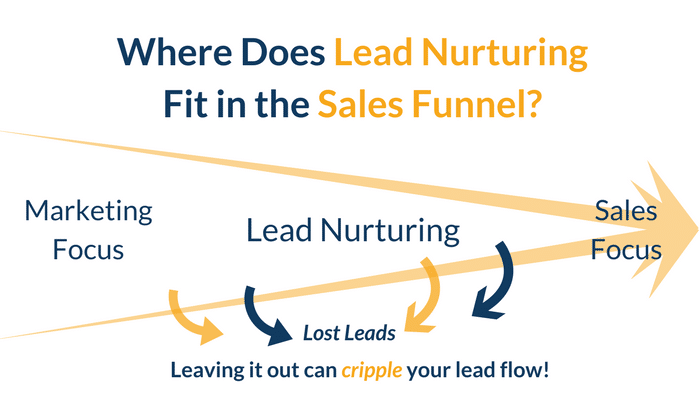If every lead was a guaranteed sale, your life would be easier, and we’d have less to write about. But this is not our reality.
It’s critical to realize that every hard-earned win from your B2B lead generation is a beginning rather than an end. Leads require considered care to develop them into a future customer. Your lead nurturing strategy is essential to remain engaged with leads and moving them down your pipeline toward purchase.
Read on to learn what a lead nurturing program is and how you can move your leads down your sales funnel to generate high-value customers.
Overview: What is lead nurturing?
Lead nurturing systematically deploys strategic marketing to the leads in your pipeline. Lead nurturing delivers optimized messaging across your lead funnel. The idea is to use relevant, personalized messaging and marketing assets, at the optimum time, to move leads down the pipeline toward a purchase.

Grow leads from an email to a highly qualified lead for sales outreach. (Image source: Author
Optimizing outreach across your list is an essential component of your larger lead management strategy. Nurturing leads assists in lead qualification tactics, enabling you to learn more about your leads. The more you know about them, the better you can score leads and gauge and prioritize the leads closest to purchase.
Nurturing leads is the tail end of the strategy that begins with prospecting contacts and site visitors to generate newly qualified leads.
Why is lead nurturing important for your small business?
Lead nurturing is essential to maximize the value of your acquisition and conversion-based marketing strategies. Small businesses with limited resources must maximize efficiencies across the organization, but especially with turning prospects into leads and leads into sales.

Lead nurturing is the bridge between marketing and closed sales. (Image source: Author
It’s just as critical to master nurturing as it is to master how to prospect and generate leads for your sales team. These two disciplines, acquisition and nurturing, are the yin and yang in any revenue-driven marketing strategy.
Your sales leads get pummeled with hundreds of emails every day. You owe it to them as potential customers to differentiate your lead marketing and nurture campaigns from this email onslaught.
A successful nurture campaign delivers mutually valuable content for you and your leads, simultaneously educating and motivating your contacts to contract or purchase.
5 strategies for successful lead nurturing
You’ll not find a single standard way to run a lead nurturing program. It depends on your industry, what you’re selling, the capabilities and maturity of your marketing campaign, and other nuance providers.
But you will find repeatable strategies for successful nurture campaigns that can be bent and flexed into your exact needs. These five strategies do just that.
Strategy 1: Segment and prioritize leads in nurture funnel
Successful lead management practices require in-depth segmentation and prioritization. All leads are unique, which is why personalized outreach is critical. But you need a way to identify and prioritize leads that are closer to purchase.
Every lead you bring into your nurture pipeline is a victory. But the real victory is moving a lead to a purchase. Some leads may never engage with your nurture content. Others may open every email but never make a purchase.
By identifying those leads that signal their purchase intent, you can prioritize their outreach with more sales-driven, bottom-of-funnel messaging to encourage a purchase.
Strategy 2: Implement lead scoring tools
The best way to prioritize leads is with lead scoring tools. These capabilities are common in CRM tools as well as marketing and sales automation platforms.
Lead scoring tools automatically assign leads in your pipeline a score that corresponds with their likelihood to buy. The tools generate scores by tracking the lead’s engagement and behaviors across your website and marketing outreach.
Opening your email newsletter will reflect positively in that lead’s score. Clicking through the newsletter and engaging with the site is even more positive. And reviewing pricing information and a blog on implementation would boost the score to the max and likely trigger a hand-off to a sales person.
Lead scoring is essential to maximize the return on your nurture program because it offers quantified values that you can use as parameters for different content tracks.
You likely don’t want to send pricing and implementation content to leads with lower scores. Lead scoring defines content tracks that correspond to where leads are in the funnel.
Strategy 3: Build multiple targeted content tracks
It’s important to realize the dynamic and fluid nature of your nurture program. Lead scores can change on a dime in either direction. Which is why successful nurture programs depend on different tracks of content to keep leads engaged.
Content tracks can be organized by topics, industry, funnel level, and any number of ways you can segment your audiences. You build multiple targeted content tracks to widen your web and keep leads engaged with your content by narrowing the focus of your tracks.
This hypothetical example shows how it can look and why it’s important:
I’m selling a marketing automation platform to marketing teams across industries. I know that my targeted job titles are managers, directors, and vice presidents of marketing.
Each of these titles have varying roles and responsibilities within marketing. Managers and directors will be more hands on and in-the-weeds with their platforms.
Vice presidents care about high-level efficiency, reporting, and ROI. I therefore would want to exclude vice presidents from nurture paths about how to write better social media posts or design cleaner marketing emails. That’s not their role.
I’ll want to create targeted content tracks for vice presidents that focus on reporting, breaking down silos, boosting marketing ROI, and similar high-level topics.
Note that this wouldn’t be one content track for marketing vice presidents, but individual tracks that offer three to four touch points each around the same topic. This way you can present a new topic/track to vice presidents that don’t engage with the reporting track.
You can see how this quickly gets granular. That’s fine. Don’t let it overwhelm you. Just make sure you either already have the catalog or at least have the ability to quickly generate content to fuel multiple nurture tracks.
Strategy 4: Engage with nurture content across channels
Lead nurturing strategies have been almost exclusively executed through email. While email will remain the key component of nurture campaigns, modern drip campaigns require a combination of channels.
The advent of marketing automation tools has unlocked new channels to employ for nurturing leads, including social media, paid ads and retargeting, dynamic website content, and more.
This may seem like a daunting task if you’re a team of one, but it’s unavoidable and shouldn’t be ignored. There’s never been an easier time to upskill and bring on new marketing tools. And it’s increasingly more critical for a successful nurture program.
The same lead scoring and content tracks that have typically been employed for email drip campaigns port over to these other channels. Multiple content tracks, segmenting, personalization, and others are all essential nurture components across any channels.
Strategy 5: Define roles and process for sales handoffs
Nurturing leads keeps them engaged with your brand and offerings while moving them down funnel toward a purchase. An often overlooked part of this process is the handoff to sales for closing the deal.
This won’t apply to all companies, but those that have a more complicated sales process need to define when and how to transition a lead out of the nurture program and into a sales process.
Lead scoring is an essential part of this handoff process. If your lead scoring is base 10, you can set a trigger so that a lead is sent to a salesperson after their score hits a 9 or higher.
This triggered component is essential to automate the transition from nurture track to sales person. Just as essential is what you share as you transition the lead.
Great marketers deliver highly qualified leads to sales teams so they have all the relevant information and more to engage in professional and personal conversation. You must find a way to convey what you’ve learned about leads as you hand them over to sales.
This is where a CRM system or robust marketing automation tool comes in handy. These platforms provide customer profiles that you can use to notate valuable lead information. Sales can then reference these notes to determine their personalized engagement plan that will hopefully close the deal.
Lead nurturing is the bridge from acquisition to sale
Employing all of these lead nurturing strategies will boost your sales. Each strategy is essential to delivering thorough nurture marketing to the right leads at the best possible time.
Marketing automation tools are the essential foundation on which to launch your campaign. And integration with a CRM is crucial to bridge the gap between marketing and sales.
As consumers and professionals continue being doused in messaging, it’s critical that you deploy thoughtful and engaging nurture content that entices, delights, and informs your targeted audiences. It’s easier said than done, but lead nurturing is the bridge from your acquisition marketing to the money.
Our Small Business Expert
We're firm believers in the Golden Rule, which is why editorial opinions are ours alone and have not been previously reviewed, approved, or endorsed by included advertisers. The Ascent does not cover all offers on the market. Editorial content from The Ascent is separate from The Motley Fool editorial content and is created by a different analyst team.